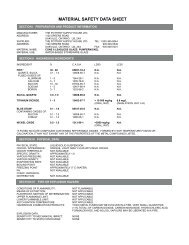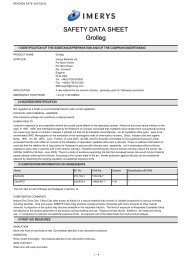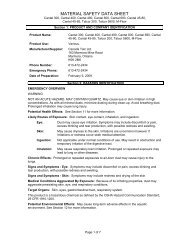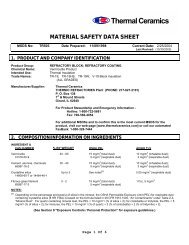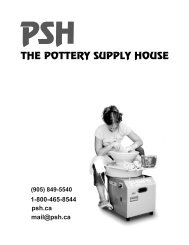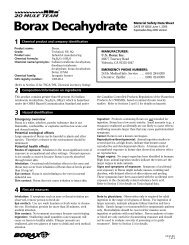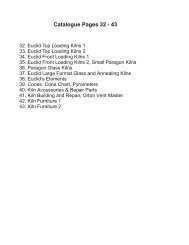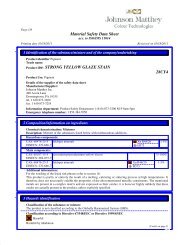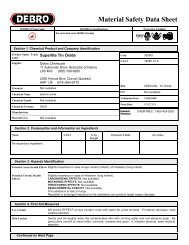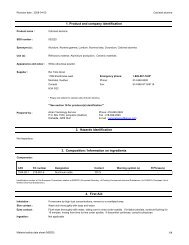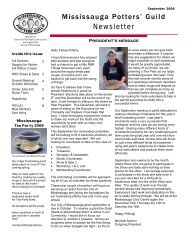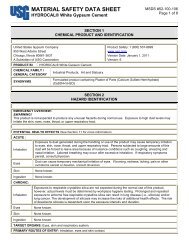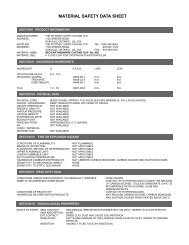KTS-2 Ball Clay
KTS-2 Ball Clay
KTS-2 Ball Clay
You also want an ePaper? Increase the reach of your titles
YUMPU automatically turns print PDFs into web optimized ePapers that Google loves.
MATERIAL SAFETY DATA SHEETProduct Trade Name(s):Common Names(s):Chemical Formula:CAS Number:Physical Form:<strong>KTS</strong>-2 <strong>Ball</strong><strong>Ball</strong> <strong>Clay</strong>, Kaolinitic <strong>Clay</strong>Al 2 Si 2 O 5 (OH) 41332-58-7Light gray to brown powderWash thoroughly after handling and before eating or drinking.Respiratory Protection: If respirator is required, use of a MSHA/NIOSH or OSHA/NIOSH approved respiratoris recommended.Ventilation:Use exhaust ventilation, if required, to maintain dust concentration below recommendedexposure limits.Protective Equipment: Wear side shield safety glasses. Rubber gloves are recommended for prolongedexposure.Wear proper personal protective equipment. Avoid confined spaces and areas with poor ventilation. Avoid eye andskin contact. Do not ingest this product. Avoid inhalation of product dusts.Section 9 - PHYSICAL AND CHEMICAL PROPERTIESPhysical State: Solid Boiling Point: Not ApplicableAppearance & Odor:Light gray to brown powder with Freezing Point: Not Applicableearthy odorpH (Aqueous Suspension): 3.5 – 7.5 Vapor Pressure: Not ApplicableSpecific Gravity: 2.4 – 2.65 Vapor Density: Not Applicable% Solubility in Water: NegligiblePartition coefficient: Not applicable Decomposition Not ApplicablePoint:LEL: Not Applicable Flash Point: Not ApplicableUEL: Not Applicable Auto-Ignition: Not ApplicableSection 10 - STABILITY AND REACTIVITYChemically Stable? Yes X No___Compatible with Other Substances? Yes X No ___ (See below)Conditions to Avoid: None knownIncompatibility (Materials to Avoid): None, inert and nonreactivePossibility of Hazardous Reactions: None knownHazardous Combustion Products: NoneHazardous Polymerization: NoneExplosion Data: Sensitivity to Mechanical Impact: Not applicableExplosion Data: Sensitivity to Static Discharge: Not applicableHazardous Decomposition/By-Products: <strong>Ball</strong> clay is stable under normal conditions. When exposed to hightemperatures, free quartz can change crystal structure to form tridymite (above 870 o C) or cristobalite (above1470 o C) which have higher health hazards than quartz. (Tridymite and cristobalite (TWA-TLV) = 0.025 mg/m 3 .Section 11 - TOXICOLOGICAL INFORMATIONKaolin - CAS No. 1332-58-7Primary Route of Exposure: X Skin;X Eye Contact; X Inhalation; X IngestionAcute Health Hazards:Eye contact may cause mechanical irritation.Date Prepared: 06 February 2011Prepared by: Imerys North America Ceramics Technical Department (770) 645-3689Revised: N/APage 3 of 8
MATERIAL SAFETY DATA SHEETProduct Trade Name(s):Common Names(s):Chemical Formula:CAS Number:Physical Form:<strong>KTS</strong>-2 <strong>Ball</strong><strong>Ball</strong> <strong>Clay</strong>, Kaolinitic <strong>Clay</strong>Al 2 Si 2 O 5 (OH) 41332-58-7Light gray to brown powderSkin contact may aggravate existing dermatitis.Inhalation from prolonged and continuous exposure to excessive quantities of dust may aggravate existing asthmaticor respiratory conditions. No adverse effect expected when ingested.Product LD 50 (oral): Not availableProduct LD 50 (dermal): Not availableProduct LC 50 (inhalation): Not availableKaolin: LD50 (rat, oral)>5000 mg/kg bw and LD50 (rat, dermal)>5000 mg/kg bwToxicologically-synergistic products: Not availableKaolin - CAS No. 1332-58-7Acute Health Hazards:Primary Routes of Entry: Skin contact, eye contact, ingestion, inhalationEye contact may cause mechanical irritation.Skin contact may aggravate existing dermatitis. Inhalation from prolonged and continuous exposure to excessive quantities of dust may aggravate existing asthmatic or respiratory conditions.Ingestion of large quantities may cause gastric distress.Kaolin - Chronic Health Hazards*: LD50 (oral and dermal): Not Available LC50 (inhalation): Not AvailableCarcinogenicity*: NTP? NoIARC*? NoOSHA*? NoMutagenicity: None knownTeratogenicity: None knownReproductive Effects: None knownCrystalline Silica, Quartz CAS No. 14808-60-7Acute Health Hazards:Primary Routes of Entry: Skin contact, eye contact, ingestion, inhalationEye contact may cause mechanical irritation.Skin contact may aggravate existing dermatitis. Inhalation from prolonged and continuous exposure to excessive quantities of dust may cause silicosis or cancer.Crystalline Silica, Quartz - Chronic Health Hazards*: LD50 (oral and dermal): Not Available LC50 (inhalation): Not AvailableCarcinogenicity*: NTP? YesIARC*? Group 1OSHA*? NoMutagenicity: Not AvailableTeratogenicity: Not AvailableReproductive Effects: Not AvailableThis product typically contains crystalline silica (quartz sand) above 0.1% as a naturally occurring impurity. The International Agency forResearch on Cancer (IARC) has concluded that "crystalline silica inhaled in the form of quartz or cristobalite from occupational sources iscarcinogenic to humans (Group I)." It also noted that carcinogenicity was not detected in all industrial circumstance studies, and may bedependent on external factors affecting its biological activity or distribution of its polymorphs. (See IARC Monographs on the Evaluation ofCarcinogenic Risks to Humans, Volume 68 (1997).) Exposure to respirable silica has also been associated with silicosis, scleroderma, andnephrotoxicity. (See Occupational Lung Disorders, Third Edition, Chapter 12 (1994) and American Journal of Respiratory and Critical CareMedicine, Volume 155, pp 761-765 (1997).)Titanium Dioxide CAS No. 13643-67-7Acute Health Hazards:Primary Routes of Entry: Skin contact, eye contact, ingestion, inhalationEye contact may cause mechanical irritation.Skin contact may aggravate existing dermatitis. Date Prepared: 06 February 2011Prepared by: Imerys North America Ceramics Technical Department (770) 645-3689Revised: N/APage 4 of 8
MATERIAL SAFETY DATA SHEETProduct Trade Name(s):Common Names(s):Chemical Formula:CAS Number:Physical Form:<strong>KTS</strong>-2 <strong>Ball</strong><strong>Ball</strong> <strong>Clay</strong>, Kaolinitic <strong>Clay</strong>Al 2 Si 2 O 5 (OH) 41332-58-7Light gray to brown powderInhalation from prolonged and continuous exposure to excessive quantities of dust may cause cancer. May result in mild fibrosis (scarring ofthe lungs)Not expected to be a hazard via ingestion.Titanium Dioxide - Chronic Health Hazards*: LD50 (oral and dermal): Not Available LC50 (inhalation): Not AvailableCarcinogenicity*: NTP? NoMutagenicity: Mammalian somatic cells.IARC*? 2BTeratogenicity: Not AvailableOSHA*? NoReproductive Effects: Not AvailableSensitization to product: The product is not a skin/respiratory sensitizer (i.e. contact with this product is not expectedto cause sensitization, based on the available data and the known hazards of the components).This product is not known to contain any components at ≥0.1% that have been shown to cause reproductive toxicity.Therefore, based upon the available data and the known hazards of the components, this product is not expected tobe a reproductive toxin.This product is not known to contain any components at ≥0.1% that have been shown to cause teratogenicity and/orembryotoxicity. Therefore, based upon the available data and the known hazards of the components, this product isnot expected to be a teratogen/embryotoxin.This product contains a component at ≥0.1% that have been shown to cause mutagenicity: titanium dioxide.Therefore, based upon the available data and the known hazards of the components, this product is considered to bea mutagen.This product contains the following chemical(s) at >/0.1% that are listed as a carcinogenic compound: crystallinesilica, quartz (14808-60-7) (Considered to be carcinogenic to humans (group 1) by IARC, (Considered to be A2 byACGIH), and (Known to be a human carcinogen by NTP). Further, NIOSH has identified titanium dioxide as apotential occupational carcinogen. Therefore, this product is considered to be carcinogenic.This product typically contains crystalline silica (quartz sand) above 0.1% as a naturally occurring impurity. TheInternational Agency for Research on Cancer (IARC) has concluded that "crystalline silica inhaled in the form ofquartz or cristobalite from occupational sources is carcinogenic to humans (Group I)." It also noted thatcarcinogenicity was not detected in all industrial circumstance studies, and may be dependent on external factorsaffecting its biological activity or distribution of its polymorphs. (See IARC Monographs on the Evaluation ofCarcinogenic Risks to Humans, Volume 68 (1997).) Exposure to respirable silica has also been associated withsilicosis, scleroderma, and nephrotoxicity. (See Occupational Lung Disorders, Third Edition, Chapter 12 (1994) andAmerican Journal of Respiratory and Critical Care Medicine, Volume 155, pp 761-765 (1997).)Trace amounts of dioxin conigers, including TCDD have been detected in parts per trillion (ppt). These traceamounts are not believed to be a health risk, but Special Protections and Special Precautions (Section 8) are advised.Methods of transmission may include inhalation, ingestion, or dermal absorption. IARC Monograph Volume 69,1977 concludes that 2,3,7,8-TCDD (a dioxin) is carcinogenic to humans.Section 12 – ECOLOGICAL INFORMATIONEcotoxicity: No data available. No adverse ecological effects are expected. May affect turbidity of water ifdischarged in large quantities to lakes or streams.Mobility: This product is insoluble in water.Persistence and degradability: This product is made from a naturally occurring, abundant, innocuous mineral.Bioaccumulative potential: No data available. This product is not expected to accumulate in biota.Date Prepared: 06 February 2011Prepared by: Imerys North America Ceramics Technical Department (770) 645-3689Revised: N/APage 5 of 8
MATERIAL SAFETY DATA SHEETProduct Trade Name(s):Common Names(s):Chemical Formula:CAS Number:Physical Form:<strong>KTS</strong>-2 <strong>Ball</strong><strong>Ball</strong> <strong>Clay</strong>, Kaolinitic <strong>Clay</strong>Al 2 Si 2 O 5 (OH) 41332-58-7Light gray to brown powderSection 13 - DISPOSAL CONSIDERATIONSUnder RCRA (40 CFR 261) <strong>Ball</strong> <strong>Clay</strong> is a non-hazardous waste. Dispose of waste material in accordance with alllocal, state and Federal requirements. (Recommendation: bury under 4 feet of top soil.)Section 14 - TRANSPORT INFORMATIONDOT Classification: Not RegulatedIATA Classification: Not RegulatedIMO Classification: Not RegulatedTDG: Not regulatedInternal UN: Not RegulatedSection 15 - REGULATORY INFORMATIONCERCLA: <strong>Ball</strong> <strong>Clay</strong> is not a CERCLA listed hazardous substance.FDA: <strong>Ball</strong> <strong>Clay</strong> is not listed in the Code of Federal Regulations 21 CFR 186.1256 as GRAS (Generally RecognizedAs Safe) for use in the manufacture of paper and paperboard that contact food.SARA Title III Section 302 Extremely Hazardous Substances: This product does not contain extremelyhazardous substances subject to the reporting requirements of Section 302 of Title III of the Superfund Amendmentsand Reauthorization Act of 1986 and 40 CFR Part 355.SARA Title III Section 311 and 312 Health and Physical Hazard Categories per 40 CFR 370.2:Immediate Delayed Fire Pressure ReactivityYes Yes No No NoSARA Section 313 Notification: This product does not contain toxic chemicals subject to the reportingrequirements of Section 313 of Title III of the Superfund Amendments and Reauthorization Act of 1986 and 40 CFRPart 372.TSCA: Product is listed in Initial Inventory, Vol. 1, Appendix A, CAS No. 1332-58-7.California Proposition 65: WARNING: This product may also contain extremely small amounts of one or morenaturally-occurring materials known to the State of California to cause cancer, birth defects, or other reproductiveharm.NJ Special Health Hazardous Substances List [4]: 2007 RTK Hazardous Substance List; Substance number 4016.PA Special Hazardous Substances List: Regulated under PA Code Chapter 323Canadian DSL: Listed, DSL (public); Part II, April 3, 1996VOC: NoneRoHS: Contains no substances in RoHS at or above reportable limitsDate Prepared: 06 February 2011Prepared by: Imerys North America Ceramics Technical Department (770) 645-3689Revised: N/APage 6 of 8
MATERIAL SAFETY DATA SHEETProduct Trade Name(s):Common Names(s):Chemical Formula:CAS Number:Physical Form:<strong>KTS</strong>-2 <strong>Ball</strong><strong>Ball</strong> <strong>Clay</strong>, Kaolinitic <strong>Clay</strong>Al 2 Si 2 O 5 (OH) 41332-58-7Light gray to brown powderREACh Status: Exempt. Product is a naturally occurring mineralSVHC: Contains no substances on the current SVHC listEINECS (EU): EC#: 310-127-6; March 2002NATIONAL INVENTORIES:DSL (Canada): ListedPICCS (Philippines): ListedKECL (Korea): ListedENCS (METI) (Japan): ListedAICS (Australia): ListedIECSC (China): ListedWHMIS: D2AThis product has been classified according to the hazard criteria of the CPR and the MSDS contains all of theinformation required by the CPR.Section 16 - OTHER INFORMATIONWhile this information and recommendations set forth herein are believed to be accurate as of the date hereof,IMERYS NORTH AMERICA CERAMICS MAKES NO WARRANTY WITH RESPECT HERETO ANDDISCLAIMS ALL LIABILITY FROM RELIANCE THEREON.IMERYS is a business name that includes Imerys North American Ceramics of which Kentucky-Tennessee <strong>Clay</strong>Company is a member. Registered in the USA. Registered Office: 100 Mansell Court East, Suite 300, Roswell, GA30076.HMIS RatingsHealth Hazard 2Flammability Hazard 0Reactivity Hazard 0Max. Personal ProtectionENFPA 704M Hazard Classification: Health: 2 Flammable: 0 Reactivity: 0References:Date Prepared: 06 February 2011Prepared by: Imerys North America Ceramics Technical Department (770) 645-3689Revised: N/APage 7 of 8
MATERIAL SAFETY DATA SHEETProduct Trade Name(s):Common Names(s):Chemical Formula:CAS Number:Physical Form:<strong>KTS</strong>-2 <strong>Ball</strong><strong>Ball</strong> <strong>Clay</strong>, Kaolinitic <strong>Clay</strong>Al 2 Si 2 O 5 (OH) 41332-58-7Light gray to brown powderAm. Rev. Respir. Dis. 1983; 127:215–220; 231–253; 141-142; Doc. Thres. Limit Values and Bio. Exp. Ind., SixthEdition, 1991: OSHA PEL-29 C.F.R. 1910.1000.Trace amounts of dioxin conigers, including TCDD have been detected in parts per trillion (ppt). These traceamounts are not believed to be a health risk, but Special Protections and Special Precautions (Section 8) are advised.Methods of transmission may include inhalation, ingestion, or dermal absorption. IARC Monograph Volume 69,1977 concludes that 2,3,7,8-TCDD (a dioxin) is carcinogenic to humans.Unless otherwise noted, all PEL and TLV values are reported as 8 hour time weighted averages (TWA).Prepared by: Imerys North America Ceramics Technical Department (770) 645-3689.Date prepared: 06 February 2011Revision: N/ADate Prepared: 06 February 2011Prepared by: Imerys North America Ceramics Technical Department (770) 645-3689Revised: N/APage 8 of 8



